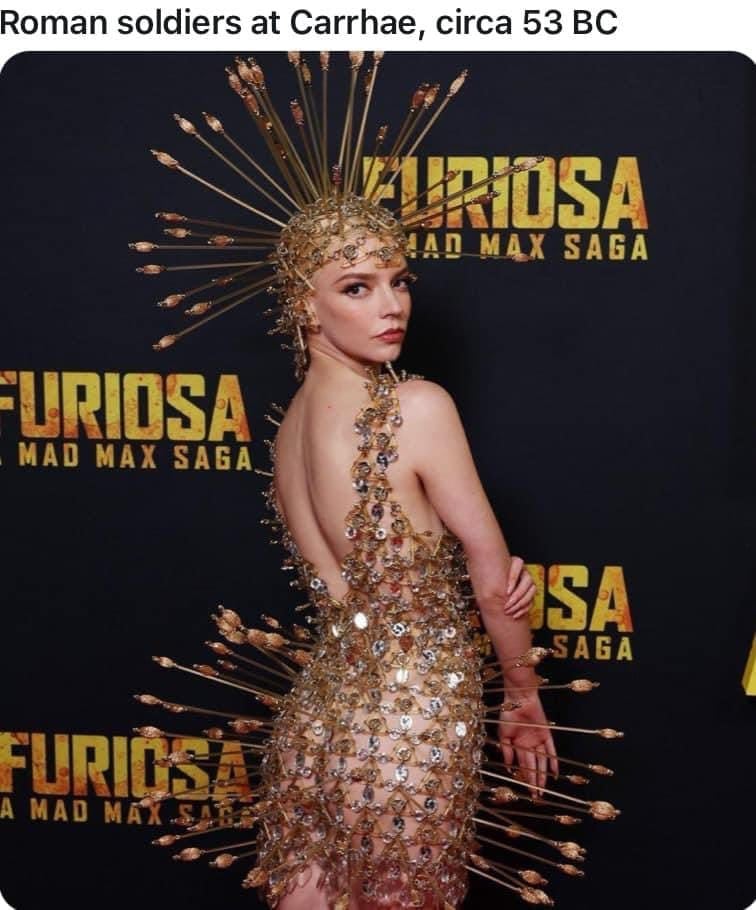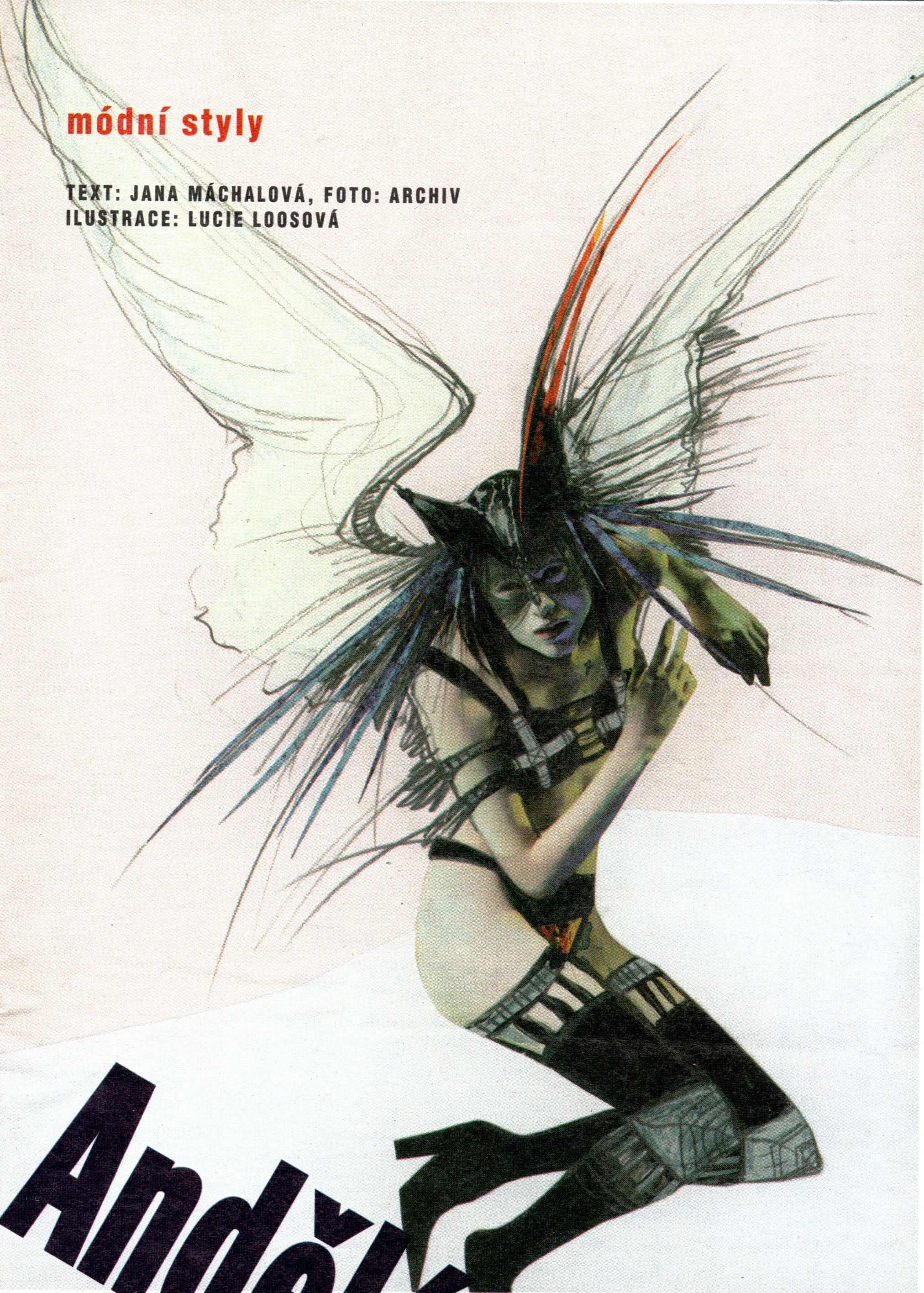Explanation: Roman soldiers are the Battle of Carrhae were pincushioned by a steady rain of Parthian arrows. The Parthians, in fact, shot so many arrows that they had to organize baggage trains of camels bring them a steady supply!
A Comm for Historymemes
A place to share history memes!
Rules:
-
No sexism, racism, homophobia, transphobia, assorted bigotry, etc.
-
No fascism, atrocity denial, etc.
-
Tag NSFW pics as NSFW.
-
Follow all Lemmy.world rules.
Banner courtesy of @[email protected]

This outfit is by Paco Rabanne in the "New Age" style. It was featured in the Angels of the Internet article in the Czech "Dnes" magazine, 2000-01-27, documenting the very weird fashion trends of the rapidly evolving online world.
Translated by DeepL with some manual correction. Czech original
Angels of the Internet
MAGAZÍN DNES+TV 1/27/2000/ fashion styles
Written by Jana Máchalová, with archival photos and illustrations by Lucie Loosová
Divine beings merge with aliens - the angel of the internetIn the early 1990s, superwomen removed gigantic shoulder pads from their jackets because bigger was no longer better. The focus was on the intellect, the hornets' nest that needed to be teased. Spiritual narcissism flourished. Even businessmen began to devour Taoist wisdom and semi-scientific theories of transcendence. Postmodern spirituality made no distinction between the sacred and the sacrilegious, nor between body and soul. Preachy meditating yogis were replaced by digital shamans, disc jockeys. Trance was no longer achieved through music alone. People went on trips with backpacks full of "smart drugs": magic mushrooms (Psilocybe), ecstasy. The versatile philosopher and writer Terence Mckenna, called by Uncle Tim himself (Timothy Leary) the LSD of the future, published books Food of the Gods and True Hallucinations. Like many others, he promoted a return to one's roots. The desire for secret rituals and practices was displayed by tattoos and piercings, and the body was opening up to new explorations. Romantic delirium and pagan roughness were in harmony with virtual reality and the internet, divine beings with aliens.
Acid jazz
Since the arrival of ravers on the scene, nothing was "hot", "cool", "hip", everything was acid (slang for LSD), just like their hypnotic "house" music. At the same time, the attitude towards clothes changed, it became very uniform. Dance marathons were attended in torn jeans, a T-shirt with a provocative or parodying slogan and a hoodie.
Over time, the fever of togetherness, the euphoria of chemistry and the house music grew stale. Acid jazz was born out of a longing for something real, something that was the opposite of synthesized. This genre of music, pioneered by British musicians, combined classical jazz with hip hop rhythms. This is why focus shifted to old records. Some were attracted to the seventies, others wandered further back to bebop and other experimental jazz styles of the late forties and fifties.
Hand in hand with musical eclecticism, clothing styles evolved.
The sounds of jazz awakened the mods' mood and interest in Italian fashion - suede-lined cardigans, skinny trousers, pointed shoes. Funk music revived the flowing swing of 1970s fashion. High-soled shoes, leather vests, chickenfoot-patterned pants, imitation fur and leather began to be worn. Hippie pants, berets and sharp beards of bebop players, corduroys and worn beatnik pullovers and B-boy hats appeared. The Adidas shoes were made popular again by black rap musicians in the 1980s. They believed they would bring them success, like Jesse Owens, the black American runner who won four gold medals in 1936, wearing shoes made by Adolf Dassler.
Also worn were scampi, wide canvas trousers and check shirts in the skaters style by Stussy. The company was at the forefront of new street fashion trends from the early 1990s. It is thanks to it that the famous brands Jive, Fresh, Fuct and X Large were created.
The acid jazz scene has never been homogeneous. It was not a subculture but a world that emphasised individuality, both in music and streetwear. This is quite rare in the history of street fashion. In this sense, this subculture, which is a unique synthesis of many styles, became the springboard for future club culture. In a way that was directly postmodern, it mixed and combined the fragments and ingredients of the past into a fresh concoction of an entirely new flavor.
Technos
Technos grew into a huge subculture in the early 1990s. They were an offshoot of the ravers movement, which eventually dissolved into a sort of fad. The ravers only persisted perhaps "in the more tucked away corners of America, where all the novelties stick around longer". It was no longer good enough to go to clubs in cosmopolitan cities wearing a "Smiley" T-shirt. Most of the renegades from the ravers movement were promiscuous in their attitude to both dress and music. One day they showed up to a party in black leather, the next day in ironic sixties clothes.
Technos, however, strictly distanced themselves from anyone who was obsessed with fashion. They decided to wander deeper into the synthetic, fast-pounding heart of "acid house music" and strip it of excess emotion. Their direct predecessors were black Detroit musicians and the first electronic experimenters - members of Kraftwerk and Tangerine Dream.
The cities of northern Europe and Japan became special "techno" centers. Getting to the core of this movement meant traveling to Berlin, Frankfurt, Tokyo, wherever there were enthusiasts with a passion for tech.
The hard and sinister image of the adherents of this subculture corresponded to the mechanical, for many hard to bear music.
They dressed in camouflage jackets, hazmat and urban assault suits. They resembled apparitions from science fiction disaster movies. Their penchant for technology and futuristic visions clearly separated them from those who, with a nostalgia that almost always preceded the end of a century, sought a mythical past.
One of the stars of this movement was the musician Moby, Richard Melville Hall, a descendant of Herman Melville, author of the famous novel Moby Dick. His song Thousand made it into the Guinness Book of Records thanks to its fiendish tempo.
Cyberpunks
It was London's Torture Garden and Submission clubs where the strange hybrids of futuristic "pervy" style and techno emerged early in the decade, the germs of a new breed of cyberpunks. They used the same trinkets (rubber hoses, gas masks, casts) and other industrial waste just like punks, but combined with holographic fabrics and fluorescent materials. Glasses with felt frames and helmets with antennae were common accessories. Their appearance was as radical and inventive as the ideology they espoused. They decided to use technical conveniences to undermine existing authorities and make changes in all structures of society.
This movement is not rooted in music but in the literary genre of science fiction, popularized primarily by the fanzine Cheap Truth by Texas writer Bruce Sterling.
In the early days, cyberpunks looked like scruffy computer meddlers with a penchant for mirrored sunglasses. Unlike the original punks, however, they didn't cling to a specific look to demonstrate group affiliation. Only their vision of the future was similar. Their interests gradually included everything from sexual stimulation using computers to holographic textiles.
This subculture also includes hackers (like Zen adepts in the world of computer experts and programmers, preaching absolute freedom and independence of information), the so-called phone phreaks, finding pleasure in abusing the telephone system, and cypherpunks, involved in cryptography.
From the work of Paco Rabanne, an adherent of New Age philosophy
Vivienne Westwood's decadent 1997 model
Fashion style supermarket
Today's clubs could be likened to laboratories, experimenting with all the street fashion styles that have accumulated over more than half a century. With a sense of humour and irony, the old is dismantled and the new assembled. Ideological as well as aesthetic differences are mixed. Where once there was one clear, comprehensible style, today we find mostly just chaos and a labyrinth of madness.
And what are the ideas of the future? In the film Blade Runner, prophesizing the world of 2019, the protagonist Deckard appears in a brown sports jacket and reddish tie, resembling a 1950s intellectual. His partner is a "1940s Spanish snitch", a dapper man in white tie, goatee and felt hat. The film's protagonist, the seductive Rachel, is presented in a 1930s dress and is the opposite of the post-punk space hooker Pris. The streets are further lined with bands of peasants in traditional dress, and heavily-contrasting punks with curled hair in jackets full of badges...
After watching this film, the question may quite legitimately arise: Will fashion finally go out of style? Will it lose its social need and function? Will we one day dress completely in our own way?
Bonus: another picture by Lucie Loosová, most likely from Ona Dnes 23-2006:

Gaul man, that's some Teutobooty
So we're all cool with the fact that she's clearly an alien right?
The important part is that she wasn't shot in the knee.
She looks like the voodoo doll of a person that is really really hated.
It's going to be a pain in the ass when she sits down ....
Cool Saint Sebastian Cosplay







